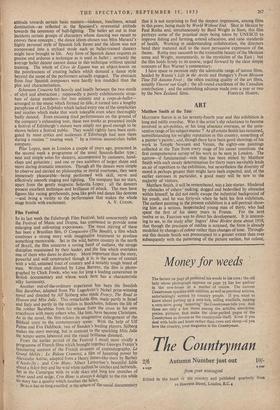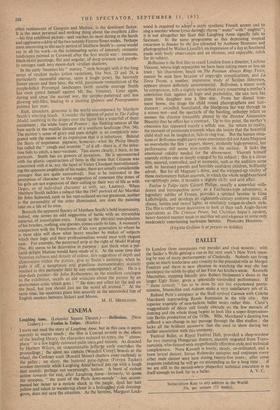ART
Matthew Smith at the Tate
MATTHEW SMITH is in his seventy-fourth year and this exhibition is long and oddly overdue. Was it the artist's shy reluctance to become involved in art-politics, or his long absences overseas, or the unin- ventive range of his subject-matter ? At all events Smith has remained, notwithstanding his weighty reputation in this country, something of a painter's painter, and, though there have been good showings of his work in Temple Newsam and Venice, the eighty-one paintings collected at the Tate from every stage of his career constitute the first comprehensive survey of his work to be seen in London. The narrow—if fundamental—vein that has been mined by Matthew Smith with such steady determination for thirty years inevitably lends an air of repetition to the exhibition, but nevertheless the diversity of mood is perhaps greater than might have been expected, and, of the earlier canvases in particular, a good many will be new to the majority of visitors.
Matthew Smith, it will be remembered, was a late starter. Hindered by obstacles of others' making, dogged and bedevilled by obstacles within himself, he did not easily escape the industrial background of his youth, and he was forty-six when he held his first exhibition. The earliest painting in the present exhibition is a self-portrait show- ing him as a serious, bespectacled young man of thirty, who had spent the first of his many years in France. For the next twelve or so, Fauvism was to direct his development. It is interest- ing to see, in the study after Ingres' Mme Riviere done about 1910, that though the precision of outline is retained, the form is already modelled by changes of colour rather than changes of tone. Through- out this decade Smith was preoccupied to a greater extent than ever subsequently with the patterning of the picture surface, but colour, often reminiscent of Gauguin and Matisse, is the dominant factor. It is the most personal and striking thing about the excellent Lilies —his first exhibited picture—and reaches its most daring in the harsh and aggressive oddity of the two notable Fitzroy Street nudes. Perhaps most interesting in this early period of Matthew Smith's—some would say in all his work—is the culminating series of intensely romantic landscapes painted in Cornwall after the first world war : ominous, black-skied paintings, flat and angular, of deep crimson and purple- lit cottages sunk into moon-dark viridian shadows.
In the early 'twenties his " mature " style brought with it the long series of opulent nudes (often variations, like Nos. 23 and 24, a particularly successful canvas, upon a single pose), the heavenly flower pieces and then later, the wild, passionate romanticism of the purple-hilled Provencal landscapes (with notable courage Smith has even pitted himself against Mt. Ste. Victoire). Later again, during and since the second war, the simpler-patterned and less glowing still-lifes, leading to a dashing Quinces and Pomegranates painted last year.
Rich, abundant, generous is the world encompassed by Matthew Smith's whirling brush. Consider the torrent of paint in The Falling Model, tumbling in the drapes over the figure like a waterfall of sheer excitement ; the white foam of Peonies ; the flashing .salmon of the bare earth in the middle distance of a southern landscape (No. 54). The painter's sense of glory and pure delight is so completely inte- grated with the means of its expression that it is infectious. Behind the flurry of impetuous pigment, however—what Sir Philip Hendy has called the " rough and stumble " of it all—there is, if the infec- tion fails to catch, a near-vacuum. This shoWs clearly, I think, in his portraits. Smith has no powers of invention. He is unconcerned with the plastic construction of form in the sense that Cezanne was concerned with it in, say, the head of Victor Chocquet (notwithstand- ing the apparent amplitude of his nudes, there are usually considerable passages that are quite unresolved). Nor is he interested in the perception of character or the suggestion of comment (the poses of his girls are not expressive of their calling or their way of life as with Degas, or of individual character as with, say, Lautrcc). When Matthew Smith tackles a subject like the 1947 portrait of Air Marshal Sir John Salmond, sunk in his vast-collared service greatcoat, neither is the personality of the sitter illuminated, nor does the painting take on a life of its own.
Beneath the apparent fluency of Matthew Smith's bold impetuosity, indeed, one senses an odd suggestion of battle with an intractable material, of irresolution even. Except in the physical manipulation of his brushes, nothing, one guesses, comes easily to him. A moment's comparison with the Frenchmen of his own generation to whom he is most akin will show what heavy weather he makes of subjects which their logic and their professionalism would treat with elegant ease. For example, the patterned strip at the right of Model Waking (No. 46) seems to be decorative in purpose : just think what a pel- lucid delight Matisse would have made of it. At the same time this Venetian richness and density of colour, this suggestion of depth and chiaroscuro within the picture, give to Smith's paintings, when he pulls it off, a sumptuous and grandiose monumentality scarcely reached in this particular field by any contemporary of his. He is a slap-dash painter—Sir John Rothenstein, in the excellent catalogue to the exhibition, recalls an old witticism about the painter by an anonymous critic which goes : " He does not often hit the nail on the head, but you should just see the wood all around." At the same time, his successes place him securely in the uncrowded line of English masters between Sickert and Moore.
M. I-I. MIDDLETON.



































 Previous page
Previous page